
Jul 27
Top 3 Turnover Metrics [Formulas & Tips]
8 Minute Read
In the dynamic world of business, understanding and managing employee turnover is crucial for maintaining a stable and productive workforce.
Turnover metrics provide valuable insights into the reasons employees leave, the impact on the organization, and strategies to retain top talent.
This blog post delves into the essential turnover metrics every business should monitor, highlighting the top three metrics in detail.
Turnover metrics provide valuable insights into the reasons employees leave, the impact on the organization, and strategies to retain top talent.
This blog post delves into the essential turnover metrics every business should monitor, highlighting the top three metrics in detail.
Understanding Turnover Metrics
Turnover metrics are quantitative measures that help organizations track and analyze the rate at which employees leave the company. These metrics can shed light on patterns and trends, enabling HR professionals and managers to implement effective retention strategies.
By keeping a close eye on turnover metrics, businesses can reduce costs associated with high turnover and foster a more engaged and loyal workforce.
By keeping a close eye on turnover metrics, businesses can reduce costs associated with high turnover and foster a more engaged and loyal workforce.
Top 3 Turnover Metrics
Here are the top Turnover Metrics you need to know.
1. Employee Turnover Rate
Employee turnover rate is a fundamental metric that measures the percentage of employees who leave an organization over a specific period, typically a year. It includes both voluntary and involuntary separations, offering a comprehensive view of workforce stability.
Calculation
Calculation
The turnover rate is calculated by dividing the number of separations during a period by the average number of employees, then multiplying by 100 to get a percentage.
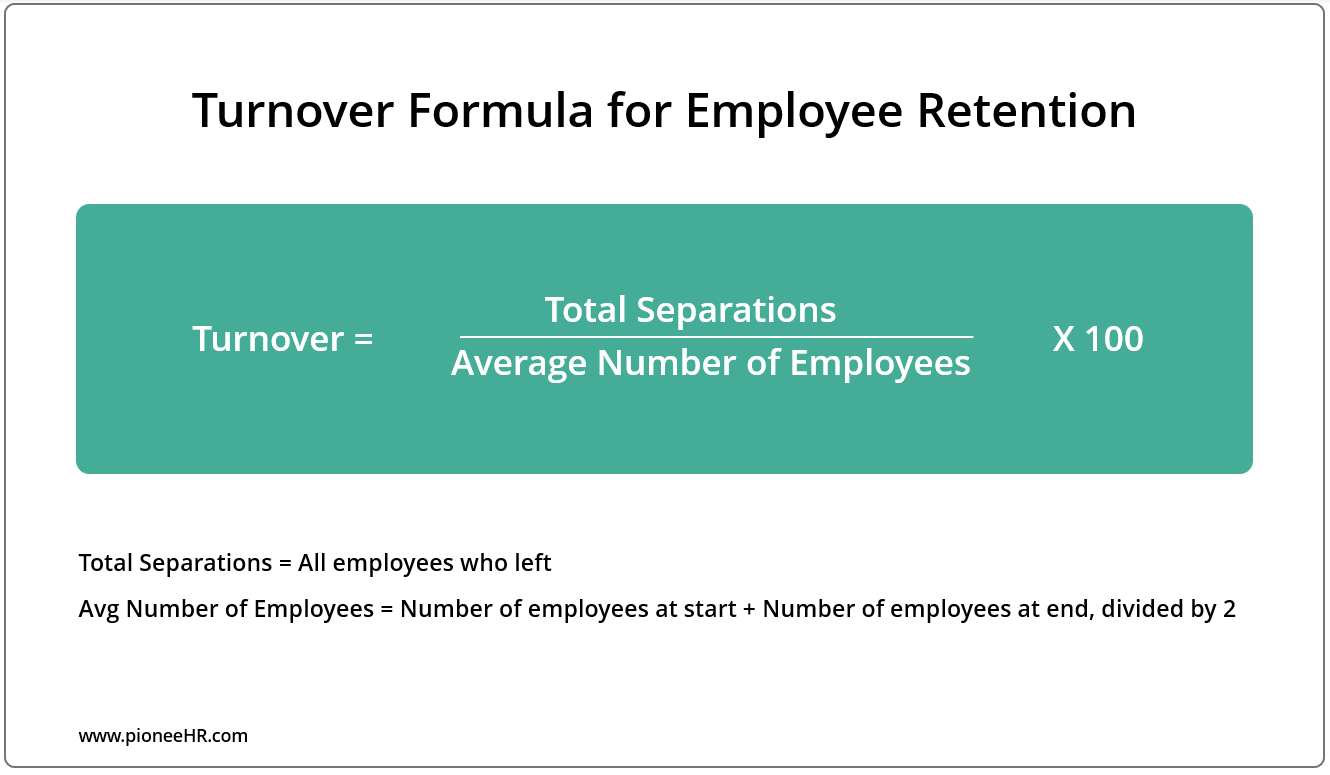
Imagine a company has an average of 200 employees throughout the year. During this year, 30 employees left the company.
Turnover Rate = (30/200) X 100
Turnover Rate = 0.15 X 100
Turnover Rate = 15%
A turnover rate of 15% means that 15 out of every 100 employees left the company over the year. This metric helps the company understand the rate at which they are losing employees and can prompt further investigation into the reasons behind this turnover.
Turnover Rate = (30/200) X 100
Turnover Rate = 0.15 X 100
Turnover Rate = 15%
A turnover rate of 15% means that 15 out of every 100 employees left the company over the year. This metric helps the company understand the rate at which they are losing employees and can prompt further investigation into the reasons behind this turnover.
Monitoring the turnover rate helps organizations identify trends and determine if the turnover is within industry benchmarks or if corrective actions are needed. A high turnover rate can indicate underlying issues such as poor job satisfaction, inadequate compensation, or a lack of career development opportunities.
2. Voluntary Turnover Rate
Voluntary turnover rate specifically tracks the percentage of employees who leave the organization by choice. This includes resignations for reasons such as better job opportunities, personal reasons, or dissatisfaction with the current role or workplace.
Calculation
Calculation
The voluntary turnover rate is calculated by dividing the number of voluntary separations by the average number of employees, then multiplying by 100.

In the same company with 200 average employees, suppose 20 out of the 30 separations were voluntary (employees resigned on their own).
Voluntary Turnover Rate = (20 / 200) × 100
Voluntary Turnover Rate = (20 / 200) × 100
Voluntary Turnover Rate = 0.10 × 100
Voluntary Turnover Rate = 10%
A voluntary turnover rate of 10% indicates that 10 out of every 100 employees chose to leave the company on their own. This can highlight issues related to job satisfaction, company culture, or career development opportunities.
Focusing on voluntary turnover provides insights into employee satisfaction and engagement. A high voluntary turnover rate suggests that employees may not be finding fulfillment or growth within the organization, prompting a need for improved retention strategies and employee engagement initiatives.
3. Retention Rate
The retention rate measures the percentage of employees who remain with the organization from the start of a specific period to its end.
Many people believe Retention Rate to be the inverse Turnover, but they're actually different.
Unlike turnover, which accounts for all departures, retention excludes those who joined and then left after the period began.
This distinction provides a clearer picture of the organization's ability to keep its original employees over time, offering more precise insights into workforce stability and loyalty.
Many people believe Retention Rate to be the inverse Turnover, but they're actually different.
Unlike turnover, which accounts for all departures, retention excludes those who joined and then left after the period began.
This distinction provides a clearer picture of the organization's ability to keep its original employees over time, offering more precise insights into workforce stability and loyalty.
Retention rate is calculating the percentage of employees who are retained from the opening count.
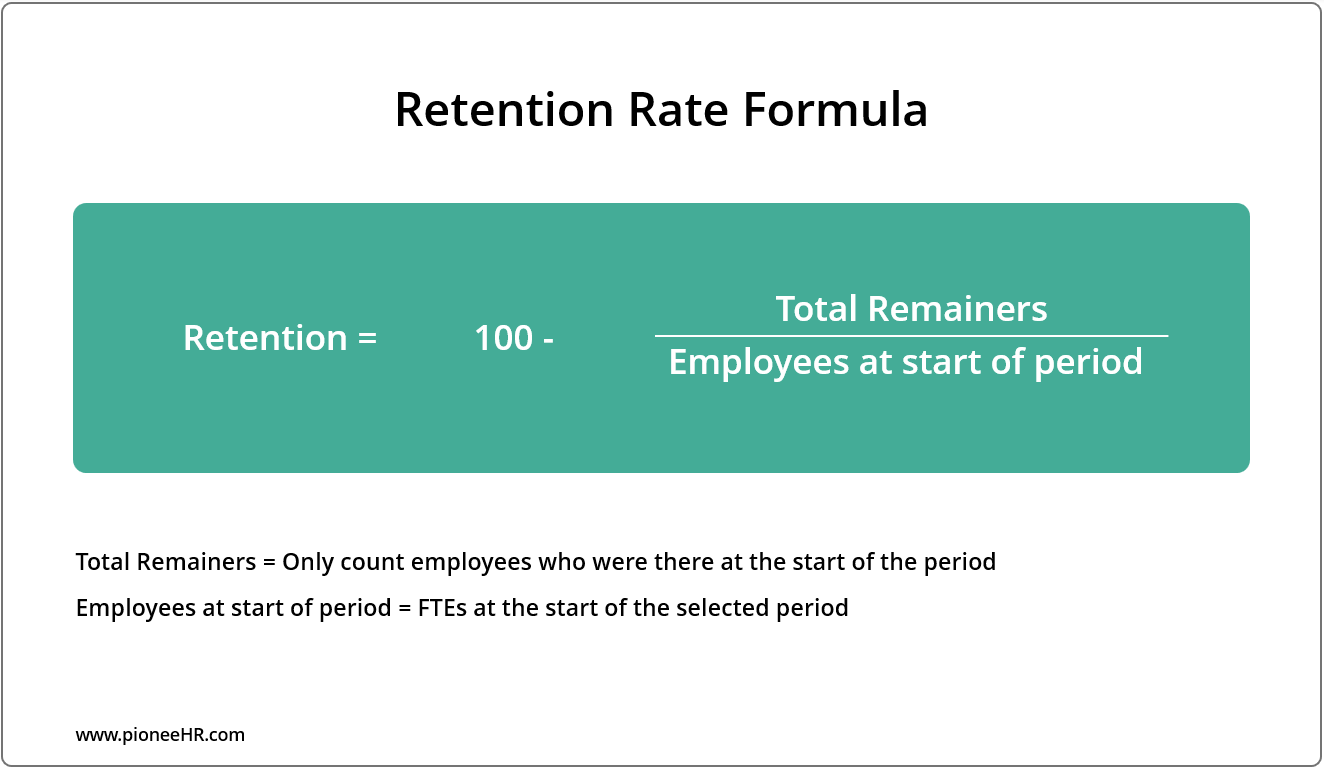
So suppose you had 120 employees on the first day, and at the end of the year 18 people left. But 4 of those leavers joined after the first day, so those will be excluded.
Retention Rate = 100 - (14 / 120)
Retention Rate = 100 - 11.6
Retention Rate = 88.4%
This means that of the 120 original employees at the beginning of the selected period, 88.4% were still there at the end of the selected period.
A high retention rate indicates a stable and satisfied workforce, which can lead to improved productivity, higher morale, and lower recruitment and training costs. Monitoring the retention rate helps organizations understand their success in retaining talent and identify areas for improvement.
Retention Rate = 100 - (14 / 120)
Retention Rate = 100 - 11.6
Retention Rate = 88.4%
This means that of the 120 original employees at the beginning of the selected period, 88.4% were still there at the end of the selected period.
A high retention rate indicates a stable and satisfied workforce, which can lead to improved productivity, higher morale, and lower recruitment and training costs. Monitoring the retention rate helps organizations understand their success in retaining talent and identify areas for improvement.
What Affects your Turnover?
Two thirds of companies report that retention is a bigger problem than hiring. And that shouldn't be surprising, since employees job hopping between companies is on the rise and data shows that companies are letting people go, when they could have retained them, often for cheaper.

As the above graph shows, job switchers grow their wages quicker than those who stay in their roles. But compensation isn't the only thing affecting turnover. So here are some ways you can improve your retention.
1. Job Satisfaction
Job satisfaction is crucial for retention. Creating an environment where employees feel valued and engaged is essential. Studies show that regular feedback, recognition programs, and aligning roles with employees' skills and interests significantly boost satisfaction.
Studies indicate that employees who are happy in their jobs stay twice as long as those who are not, which indicates just how important satisfaction is to employees.
As the below graph shows, the top reasons for preventable leavers - note the absence of a pay rise as one of the top reasons.
Studies indicate that employees who are happy in their jobs stay twice as long as those who are not, which indicates just how important satisfaction is to employees.
As the below graph shows, the top reasons for preventable leavers - note the absence of a pay rise as one of the top reasons.
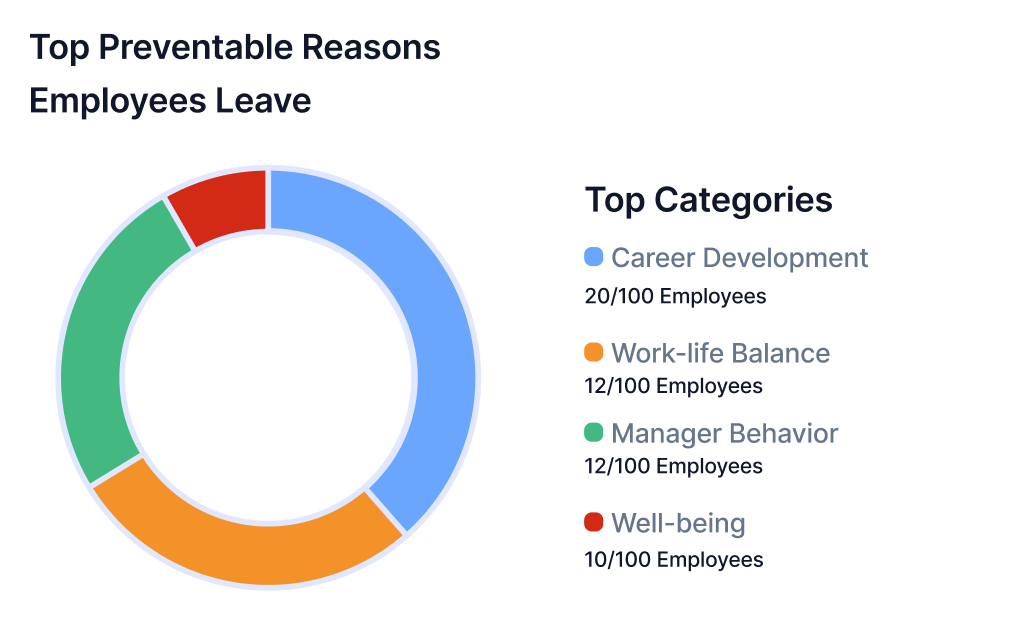
2. Career Development Opportunities
Providing clear career development paths and opportunities for advancement is vital for retaining talent. Employees need to see a future within the organization. Offering training programs, mentorship, and promoting from within can motivate employees to stay and grow with the company.
Remarkably, 94% of employees would stay longer at their organization if it invested in their career development
Remarkably, 94% of employees would stay longer at their organization if it invested in their career development
3. Work-Life Balance
Encouraging a healthy work-life balance can significantly improve retention. Flexible work arrangements, such as remote work options and flexible hours, help employees manage their personal and professional lives more effectively.
Data shows that organizations offering remote work options have a 25% lower employee turnover rate.
Data shows that organizations offering remote work options have a 25% lower employee turnover rate.
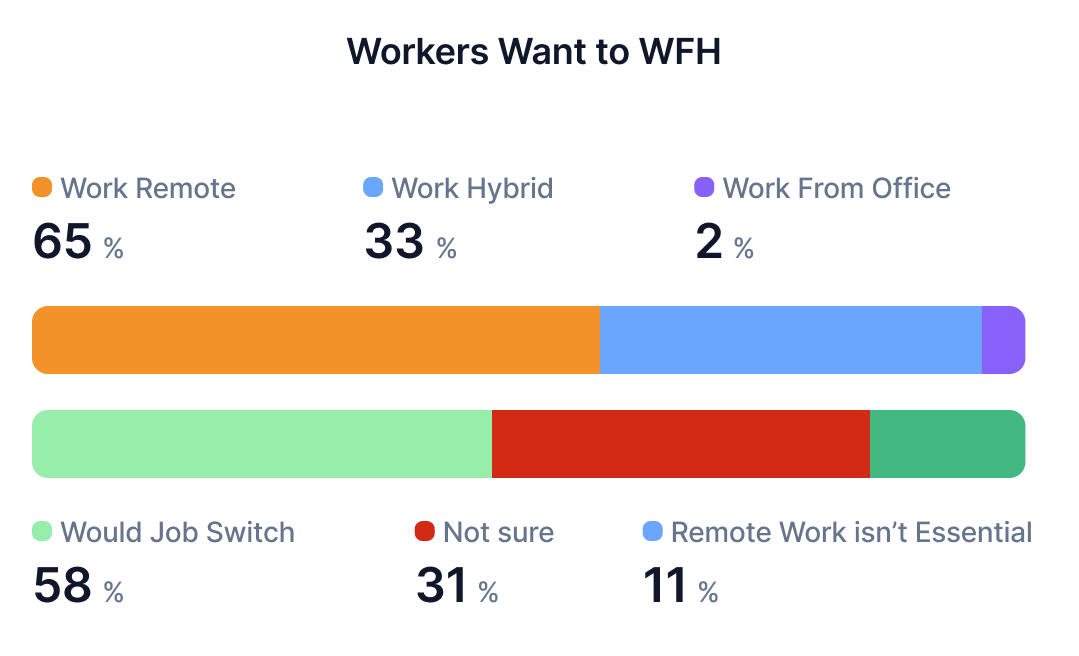
4. On-boarding Experience
It's surprising, but to reduce people leaving, you actually need to focus on the newbies. Improving the onboarding experience can make a huge difference.
According to the Work Institute's 2022 Retention Report, effective onboarding can slash new employee turnover by up to 82%. When new hires feel welcomed and understand their roles from the get-go, they’re more likely to stick around.
Good onboarding helps them blend into the company culture and clears up any early confusion.
This makes them feel valued and part of the team, which boosts their commitment. So, by making sure newcomers start off on the right foot, you’re setting the stage for a more loyal and stable workforce.
According to the Work Institute's 2022 Retention Report, effective onboarding can slash new employee turnover by up to 82%. When new hires feel welcomed and understand their roles from the get-go, they’re more likely to stick around.
Good onboarding helps them blend into the company culture and clears up any early confusion.
This makes them feel valued and part of the team, which boosts their commitment. So, by making sure newcomers start off on the right foot, you’re setting the stage for a more loyal and stable workforce.
How to Achieve a Good Turnover Rate?
Improving employee retention can feel like a puzzle, but with the right tools and strategies, you can piece it together. Here are some tips to help keep your team happy and reduce turnover, focusing on constantly measuring metrics, using surveys and data, and implementing dashboards.
1. Keep an Eye on Retention Metrics
Think of retention metrics as your company’s health check-up. Regularly tracking these metrics helps you spot any issues early on. Key metrics to monitor include overall turnover rate, voluntary turnover rate, and retention rate. By keeping a constant watch on these numbers, you can see trends and address potential problems before they become major headaches.
2. Use Employee Surveys
Employee surveys are like having a direct line to your team’s thoughts and feelings. Regularly asking for their input through surveys helps you understand what makes them happy and what might be causing dissatisfaction. Tools like pulse surveys, stay interviews, and exit interviews provide valuable insights. For instance, according to Gallup, companies that actively use employee engagement surveys have significantly lower turnover rates. It’s all about knowing what your employees need and want
3. Analyze the Data
Gathering data is great, but it’s what you do with it that counts. Dive into the numbers to find out what's really going on. Are there patterns in the reasons why people leave? Is there a specific department with higher turnover? Use this information to make informed decisions. For example, if data shows that work-life balance is a major issue, you can look into offering more flexible working arrangements.
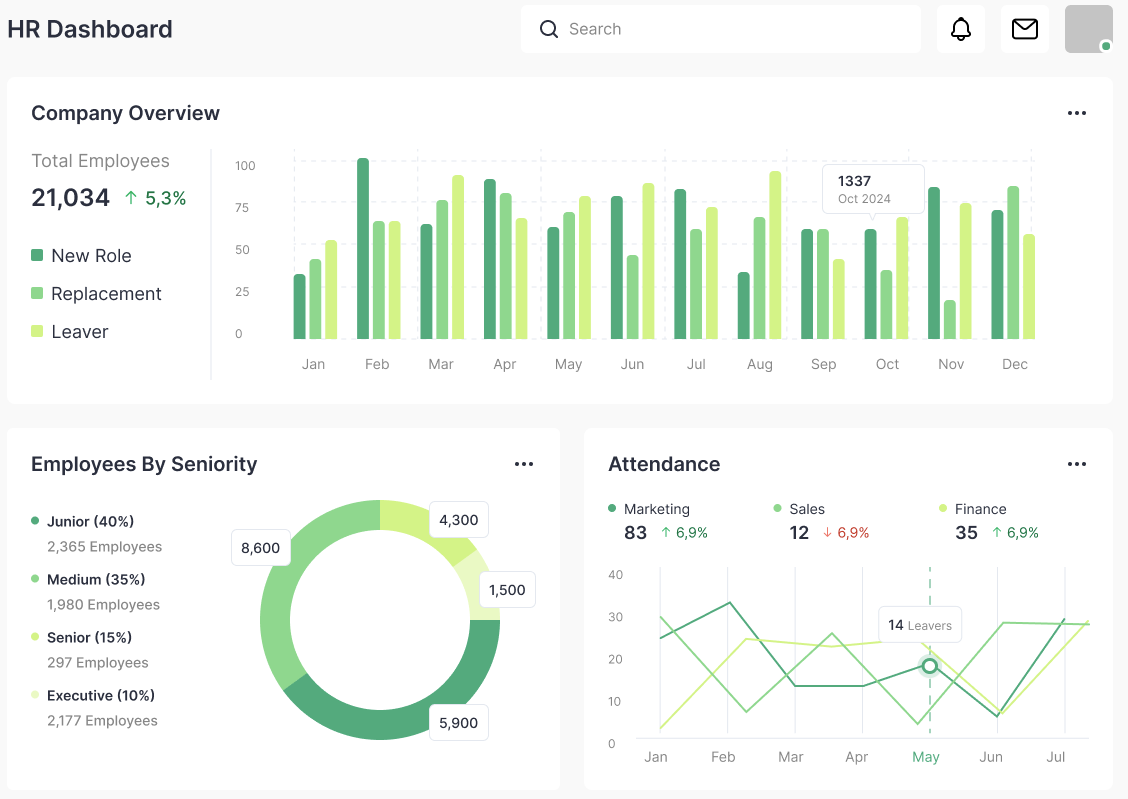
4. Implement Dashboards
Dashboards are your best friend when it comes to visualizing data. They provide a real-time snapshot of key metrics, making it easy to spot trends and issues at a glance. With dashboards, you can track everything from employee satisfaction scores to turnover rates in one place. This helps in making quick, data-driven decisions. Tools like Tableau, Power BI, or even custom HR dashboards can be incredibly useful here.
5. Act on Feedback
Getting feedback is step one, but acting on it is what really matters. If surveys reveal that employees feel undervalued, start recognizing and rewarding their efforts more frequently. If data shows that career development is a concern, invest in training programs and clear career paths. Showing employees that their feedback leads to real changes can significantly boost morale and retention.
6. Foster a Positive Culture
A positive work culture is a magnet for retention. Create an environment where employees feel valued, respected, and part of a community. Encourage teamwork, celebrate successes, and promote a healthy work-life balance. A strong, positive culture makes employees want to stay.
7. Use Technology
Leverage technology to streamline HR processes. Use tools that make it easier to collect, analyze, and act on data. HR software can automate surveys, track metrics, and even provide predictive analytics to foresee potential turnover risks.
8. Continuous Improvement
Retention strategies are not a one-and-done deal. Continuously improve your approaches based on feedback and data. Stay updated with the latest trends in employee engagement and retention strategies.
Conclusion
In short, improving retention is all about staying connected with your team, using data wisely, and making your workplace a great place to be. By regularly measuring metrics, listening to your employees through surveys, and using dashboards to keep track of everything, you can create a happy, loyal workforce. And remember, it’s all about showing your employees that you care and are willing to make changes to keep them satisfied.
Copyright © 2025
